RAF HARVARDS AT WAR
No. 1340 (Special Duties) Flight RAF
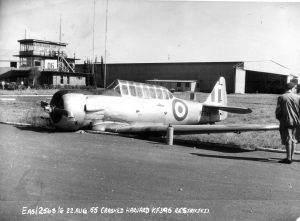
Some accounts maintain that the British response to the Mau Mau rebellion in Kenya in the mid-1950s provides an illustration of how the ‘Malayan model’ was drawn on to suppress insurgencies elsewhere. … By 1953, the active wing of the Kikuyu rebel movement could commit between 12,000 and 15,000 men to their campaign to recover farmland lost to white settlers, but this force was sustained by a ‘passive’ wing that numbered perhaps another 30,000, including elements of Kenya’s urban population. …
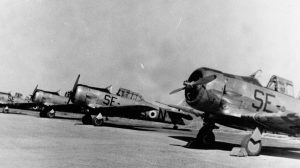 The impact of air operations during the Mau Mau rebellion has never been easy [to assess] … There were those who claimed that air operations were at best ineffective and at worst counterproductive. This would hardly be surprising given the constraints imposed by the environment and the weather, the fact that the Harvards were not designed for use as offensive platforms, that their 20lb bombs, intended for operations in open country, produced minimal kinetic effect in dense jungle environments, and that few 1340 Flight personnel had much experience in the field of offensive or tactical air support.
The impact of air operations during the Mau Mau rebellion has never been easy [to assess] … There were those who claimed that air operations were at best ineffective and at worst counterproductive. This would hardly be surprising given the constraints imposed by the environment and the weather, the fact that the Harvards were not designed for use as offensive platforms, that their 20lb bombs, intended for operations in open country, produced minimal kinetic effect in dense jungle environments, and that few 1340 Flight personnel had much experience in the field of offensive or tactical air support.
Yet it is important to note that the Harvards only deployed to Kenya at all in response to Army requests for air support, and it is notable that Erskine reached the conclusion after a few months that he needed more – not less – offensive air power. At the very least, their non-kinetic impact is known to have been significant. The rebels were compelled to split up into smaller groups and to stay on the move, and (as in Malaya) there was some evidence of increased surrender and desertion due to air action. Sebastian Richie. The RAF, Small Wars and Insurgencies: Later Colonial Operations, 1945-1975, Air Media Centre: London, 2011: 33-39.
The Secretary of State for the Colonies (Mr. Oliver Lyttelton)
As I informed the hon. Member for South Ayrshire (Mr. Emrys Hughes) on 6th May last, Harvard aircraft have been used to drop bombs on known hiding places of terrorist gangs in the prohibited areas in Kenya. They are also used for reconnaissance. These prohibited areas, mainly the forest ranges of the Aberdares and Mount Kenya, are known to everyone, and there is no risk to law-abiding persons. Harvard aircraft are single-engined machines, have a limited range and can only drop small bombs.
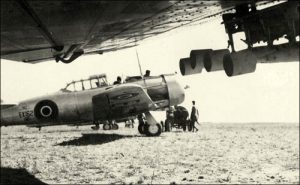 This Photograph shows a bombed-up Harvard ready to go to the ranges, and in the background Bob’s ‘best mate’ Stan Rippon winding up the thing that pulled it along, while the ‘boys’ go along with the petrol bowser.
This Photograph shows a bombed-up Harvard ready to go to the ranges, and in the background Bob’s ‘best mate’ Stan Rippon winding up the thing that pulled it along, while the ‘boys’ go along with the petrol bowser.
The operation was ‘dive bombing’ from 3000′ onto a splash target in a dam. Guns (or Gun) was carried close to the wing root in the starboard wing in training roll for target practice on the ranges.
18 July 1942 Air to Ground Firing
21 July High dive bombing 4 bombs
28 July Low level bombing 4 bombs
In fact the Harvard IIB was used for anti Mau-Mau operations in Kenya by 1340 Flight from 1953 – 55. There were altogether 18 a/c involved. They were used aggressively, carrying 20lb bombs in wing racks, but there were only 10 left by the time the ops finished.
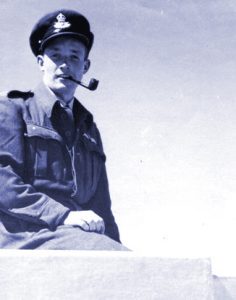
Right – Bob Aitkin – When we all started off there were 62 of us in the beginning (we finished with 47), and we were split into four flights for the purposes of ease of handling the various training programmes. Flying stopped at mid-day due to the turbulence, and continued again in the evening when temperatures cooled down. Class work went on all and every day except for week-ends, which were utilised for sports and other activities.
Within the Flights, C in my case, we all made our little groups of special friends (usually about four), shared huts and rooms together, played and swam together, went out and drank together, and became a pretty close knit little group. With this system, some flights were dead to others, and never really crossed each others paths.
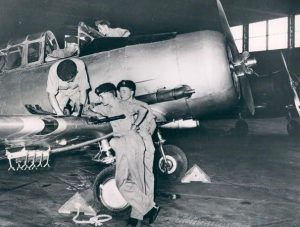 No. 1340 (Special Duties) Flight RAF (1340 Flt) was a flight of the Royal Air Force. In its first formation in India it was equipped with Vultee Vengeance Mk. IIIs and a single North American Harvard. In its second formation in Kenya it flew Harvards built under licence in Canada by Noorduyn. Although Harvards were mostly used by the RAF as trainers or target tugs, the aircraft of 1340 Flt in Kenya were armed with 20 lb (9.1 kg) bombs and a machine-gun, for operations against the Mau Mau in Kenya in the early 1950s.
No. 1340 (Special Duties) Flight RAF (1340 Flt) was a flight of the Royal Air Force. In its first formation in India it was equipped with Vultee Vengeance Mk. IIIs and a single North American Harvard. In its second formation in Kenya it flew Harvards built under licence in Canada by Noorduyn. Although Harvards were mostly used by the RAF as trainers or target tugs, the aircraft of 1340 Flt in Kenya were armed with 20 lb (9.1 kg) bombs and a machine-gun, for operations against the Mau Mau in Kenya in the early 1950s.
Flight Lieutenant Jack Sherburn: Pilot awarded a DFC for his gallantry against the Mau Mau who went on to serve in Suez and fly with Yuri Gagarin
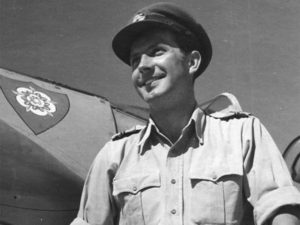 Jack Sherburn swooped over the Aberdares, the lush forests and tumbling waterfalls on the mountainsides yielding no clues – or so it seemed – to where Kenya’s rebels were hiding. Dusk, and the propeller’s whirr from his single-engined Harvard, a glimpse of a camp-fire flame – now he had them. But there was no need for any of his eight 20lb bombs. Shadowy figures scattered, fleeing the aircraft’s noise which proved terrifying enough. The flying was as difficult as it could be, sometimes 20,000 feet above mean sea level – the mountain tops reach 14,000 feet – from a dirt runway at Mweiga. He made the short hop back to the rough strip and got down safely: another sortie done. It was one of a total of hundreds, more than 450, each one of which he noted down in his dark blue log book.
Jack Sherburn swooped over the Aberdares, the lush forests and tumbling waterfalls on the mountainsides yielding no clues – or so it seemed – to where Kenya’s rebels were hiding. Dusk, and the propeller’s whirr from his single-engined Harvard, a glimpse of a camp-fire flame – now he had them. But there was no need for any of his eight 20lb bombs. Shadowy figures scattered, fleeing the aircraft’s noise which proved terrifying enough. The flying was as difficult as it could be, sometimes 20,000 feet above mean sea level – the mountain tops reach 14,000 feet – from a dirt runway at Mweiga. He made the short hop back to the rough strip and got down safely: another sortie done. It was one of a total of hundreds, more than 450, each one of which he noted down in his dark blue log book.
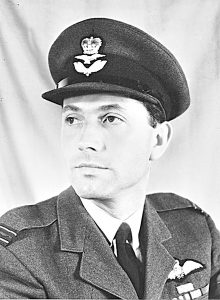 The Mau Mau gangs kept their home-made weapons concealed beneath the trees, and Britain, the colonial power, meant to overwhelm them with a show of force. Flying Officer Sherburn’s duties – under his CO, soon-to-be-Wing Commander Charles “Porky” Jeffries commanding No 1340 (Harvard Flight) – included dropping leaflets to persuade Kenya’s Kikuyu population to reject the Mau Mau. Winston Churchill was again Prime Minister, and his view was: “The more they saw an aircraft overhead, the more they would feel that all their movements were under observation.”
The Mau Mau gangs kept their home-made weapons concealed beneath the trees, and Britain, the colonial power, meant to overwhelm them with a show of force. Flying Officer Sherburn’s duties – under his CO, soon-to-be-Wing Commander Charles “Porky” Jeffries commanding No 1340 (Harvard Flight) – included dropping leaflets to persuade Kenya’s Kikuyu population to reject the Mau Mau. Winston Churchill was again Prime Minister, and his view was: “The more they saw an aircraft overhead, the more they would feel that all their movements were under observation.”
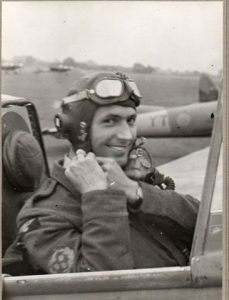 Sherburn, a proud Yorkshireman who flew with the county’s white rose emblem painted on his aircraft, trained in South Africa and volunteered for Kenya in 1953. His DFC was one of only a handful – only four are documented – to be awarded for gallant and distinguished service in operations against the Mau Mau. General George Erskine, GOC-in-Chief, East Africa Command, told pilots at a parade at RAF Eastleigh, Nairobi, in 1955 that the RAF’s participation had allowed the army to be smaller, by several regiments and a brigade, than it would have had to be without air assistance.
Sherburn, a proud Yorkshireman who flew with the county’s white rose emblem painted on his aircraft, trained in South Africa and volunteered for Kenya in 1953. His DFC was one of only a handful – only four are documented – to be awarded for gallant and distinguished service in operations against the Mau Mau. General George Erskine, GOC-in-Chief, East Africa Command, told pilots at a parade at RAF Eastleigh, Nairobi, in 1955 that the RAF’s participation had allowed the army to be smaller, by several regiments and a brigade, than it would have had to be without air assistance.
More medals and awards for Harvard Pilots –
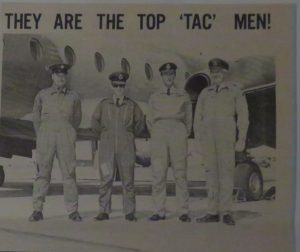
D.F.M. group (E11R). The unique award for operations against the Mau Mau, Kenya, 1955 flying an armed Harvard
The recommendation for the award from The National Archives, Kew, in AIR file 2/12423. It states:-
“Flight Sergeant Erasmus joined 1340 Flight in Jul 1953. Since then he has completed 407 sorties against the Mau Mau in Harvard aircraft. In addition he has flown 30 Skyshouting sorties in Auster aircraft. He has completed, in all, 700 hours flying on operational tasks. In the last six months he has flown 300 hours and his total flying since joining the RAF is 3,000 hours.
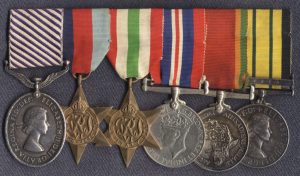 Apart from being the longest serving member of 1340 Flight, Flight Sergeant Erasmus is a determined and successful section leader. He is willing at all times, to undertake any duty however short the notice and however difficult the task. His cheerfulness is a tonic to everyone and he sets himself a standard well worthy of the highest traditions of the Royal Air Force. I strongly recommend the award of the Distinguished Flying Medal. R Bowen Officer Commanding.”
Apart from being the longest serving member of 1340 Flight, Flight Sergeant Erasmus is a determined and successful section leader. He is willing at all times, to undertake any duty however short the notice and however difficult the task. His cheerfulness is a tonic to everyone and he sets himself a standard well worthy of the highest traditions of the Royal Air Force. I strongly recommend the award of the Distinguished Flying Medal. R Bowen Officer Commanding.”
Incidents
On 5 December 1945 W/Cdr Edmondes took off solo in his Harvard (FE965) to make a reconnaissance round the Porkal area. His engined failed, and he made a successful forced landing in a paddy field about 10 miles inland. He was unhurt.
Second formation

The flight was re-formed on 23 March 1953 as No. 1340 Flight RAF at RAF Thornhill, Gwelo, Southern Rhodesia(now Gweru-Thornhill Air Base, Zimbabwe), in response to the Mau Mau uprising in neighbouring Kenya. The Harvard IIB aircraft came from No. 5 Flying Training School RAF (3rd Formation) based at Thornhill, part of the Rhodesian Air Training Group. The Harvards had been previously temporarily based at No. 4 Flying Training School RAF at RAF Heany, near Bulawayo.
The Mau Mau uprising occurred because native Kenyan cattle farmers, predominately the Kikuyu, Embu and Meru people, had been progressively pushed off their ancestral grazing lands by white settlers since 1902. The situation was made more complex because the Kikuyu were divided into anti-colonial protesters and pro-British sympathisers. Much of the air activity took place in the forested areas around Mount Kenya and the Aberdare Rangenorth of Nairobi, where the Mau Mau fighters were hiding out.
Kenya became independent in 1964. Although some Harvards from Thornhill had been offered in February 1953 to the Kenyan authorities on the advice of General William “Looney” Hinde, the Director of Operations, a decision wasn’t taken until the Chief of the Imperial General Staff, General Sir John Harding, visited Kenya to see the worsening security situation. Twelve Harvards from Thornhill were recommended to support two infantry battalions and an infantry brigade headquarters (39 Brigade), to restore security. Winston Churchill’s cabinet endorsed the move on 10 March, and by the end of the month the establishment of 1340 Flight was formally approved.
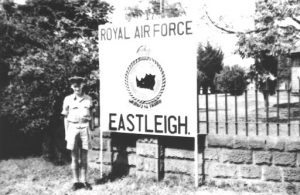 The flight arrived at RAF Eastleigh, Nairobi, Kenya, on 27 March 1953, commanded by Squadron LeaderCharles G. St. David Jefferies, equipped with 12 Noorduyn Harvard IIBs, eight operational and four in reserve, with two being serviced any one time. The aircraft were fitted with bomb racks under the wings to take eight 20 lb (9.1 kg) fragmentation bombs and a single Browning .303 machine gun under the starboard wing, with the ammunition carried inside the wing.[19] Because of the wooded terrain, the Harvards weren’t used for two months because General Hinde thought they would be ineffective.[10]
The flight arrived at RAF Eastleigh, Nairobi, Kenya, on 27 March 1953, commanded by Squadron LeaderCharles G. St. David Jefferies, equipped with 12 Noorduyn Harvard IIBs, eight operational and four in reserve, with two being serviced any one time. The aircraft were fitted with bomb racks under the wings to take eight 20 lb (9.1 kg) fragmentation bombs and a single Browning .303 machine gun under the starboard wing, with the ammunition carried inside the wing.[19] Because of the wooded terrain, the Harvards weren’t used for two months because General Hinde thought they would be ineffective.[10]
The RAF was assisted by five Piper PA-22 Tri-Pacer aircraft belonging to the Kenya Police Reserve Air Wing (KPRW). In October 1953 six RAF pilots were seconded to the KRPW to fly the Tri-Pacers. Being on secondment, the pilots adopted the attitude to discipline of the Kenya Police; it was somewhat more relaxed than that of the RAF.[citation needed] The Tri-Pacers weren’t originally armed, although they were later fitted with a single rack for four 20 lb (9.1 kg) bombs behind the rear of cabin. 1340 Flight, along with the KPRW Tri-Pacers deployed forward from Eastleigh to Nyeri airfield, which lay between Mount Kenya and the Aberdare Range, and a basic Operations Centre was set up in the nearby town of Mweiga. An RAF Regiment detachment eventually took over airfield defence from the RAF groundcrew.[15]
Operations
Working with the Army or local security forces on the ground, the Tri-Pacers would drop phosphorus grenades (e.g. No. 76 Special Incendiary Grenade) from the cockpit as markers, followed by the flight of eight Harvards which dropped their bombs on the target. From November 1953 various detachments of Avro Lincoln bombers were also stationed at RAF Eastleigh, armed with fourteen 500 lb (230 kg) bombs: No. 49 Squadron RAF, No. 100 Squadron RAF, No. 61 Squadron RAF, No. 214 Squadron RAF, and 49 Squadron again from December 1954.
There was a lack of coordination between the various armed services until May 1954 when Air CommodoreWalter Beisiegel was appointed as Senior RAF Officer (SRAFO). He stayed until September 1955 and improved the process of target-marking by the Piper Tri-Pacers and the bombing of the Mau Mau by the Harvards and Lincolns. No. 1340 Flight was disbanded on 30 September 1955. During the course of the Mau Mau emergency, the flight had dropped 21,936 20-lb. bombs and lost five aircraft in accidents.
Incidents
On 19 April 1954 three Harvards were caught in a down-draught and crash-landed in the Aberdare Range. Three Tri-Pacers were also lost to accidents.